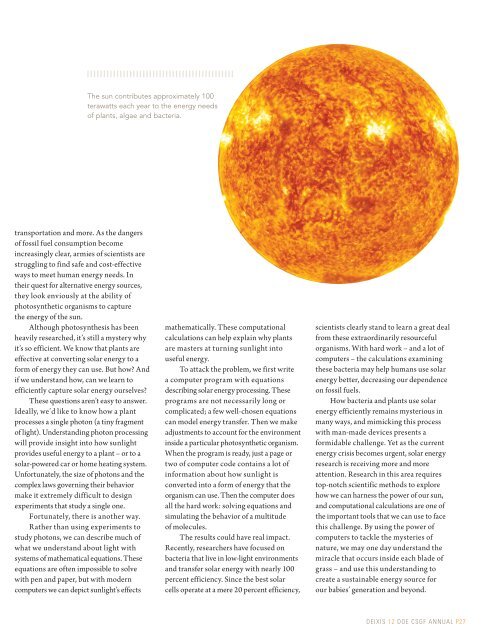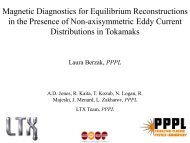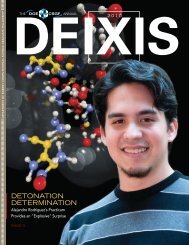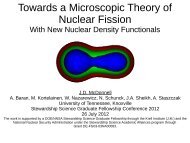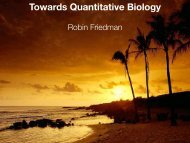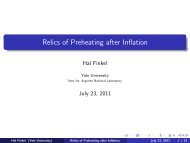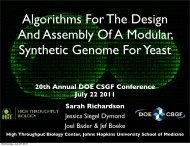2012 - Krell Institute
2012 - Krell Institute
2012 - Krell Institute
Create successful ePaper yourself
Turn your PDF publications into a flip-book with our unique Google optimized e-Paper software.
The sun contributes approximately 100<br />
terawatts each year to the energy needs<br />
of plants, algae and bacteria.<br />
transportation and more. As the dangers<br />
of fossil fuel consumption become<br />
increasingly clear, armies of scientists are<br />
struggling to find safe and cost-effective<br />
ways to meet human energy needs. In<br />
their quest for alternative energy sources,<br />
they look enviously at the ability of<br />
photosynthetic organisms to capture<br />
the energy of the sun.<br />
Although photosynthesis has been<br />
heavily researched, it’s still a mystery why<br />
it’s so efficient. We know that plants are<br />
effective at converting solar energy to a<br />
form of energy they can use. But how? And<br />
if we understand how, can we learn to<br />
efficiently capture solar energy ourselves?<br />
These questions aren’t easy to answer.<br />
Ideally, we’d like to know how a plant<br />
processes a single photon (a tiny fragment<br />
of light). Understanding photon processing<br />
will provide insight into how sunlight<br />
provides useful energy to a plant – or to a<br />
solar-powered car or home heating system.<br />
Unfortunately, the size of photons and the<br />
complex laws governing their behavior<br />
make it extremely difficult to design<br />
experiments that study a single one.<br />
Fortunately, there is another way.<br />
Rather than using experiments to<br />
study photons, we can describe much of<br />
what we understand about light with<br />
systems of mathematical equations. These<br />
equations are often impossible to solve<br />
with pen and paper, but with modern<br />
computers we can depict sunlight’s effects<br />
mathematically. These computational<br />
calculations can help explain why plants<br />
are masters at turning sunlight into<br />
useful energy.<br />
To attack the problem, we first write<br />
a computer program with equations<br />
describing solar energy processing. These<br />
programs are not necessarily long or<br />
complicated; a few well-chosen equations<br />
can model energy transfer. Then we make<br />
adjustments to account for the environment<br />
inside a particular photosynthetic organism.<br />
When the program is ready, just a page or<br />
two of computer code contains a lot of<br />
information about how sunlight is<br />
converted into a form of energy that the<br />
organism can use. Then the computer does<br />
all the hard work: solving equations and<br />
simulating the behavior of a multitude<br />
of molecules.<br />
The results could have real impact.<br />
Recently, researchers have focused on<br />
bacteria that live in low-light environments<br />
and transfer solar energy with nearly 100<br />
percent efficiency. Since the best solar<br />
cells operate at a mere 20 percent efficiency,<br />
scientists clearly stand to learn a great deal<br />
from these extraordinarily resourceful<br />
organisms. With hard work – and a lot of<br />
computers – the calculations examining<br />
these bacteria may help humans use solar<br />
energy better, decreasing our dependence<br />
on fossil fuels.<br />
How bacteria and plants use solar<br />
energy efficiently remains mysterious in<br />
many ways, and mimicking this process<br />
with man-made devices presents a<br />
formidable challenge. Yet as the current<br />
energy crisis becomes urgent, solar energy<br />
research is receiving more and more<br />
attention. Research in this area requires<br />
top-notch scientific methods to explore<br />
how we can harness the power of our sun,<br />
and computational calculations are one of<br />
the important tools that we can use to face<br />
this challenge. By using the power of<br />
computers to tackle the mysteries of<br />
nature, we may one day understand the<br />
miracle that occurs inside each blade of<br />
grass – and use this understanding to<br />
create a sustainable energy source for<br />
our babies’ generation and beyond.<br />
DEIXIS 12 DOE CSGF ANNUAL P27


